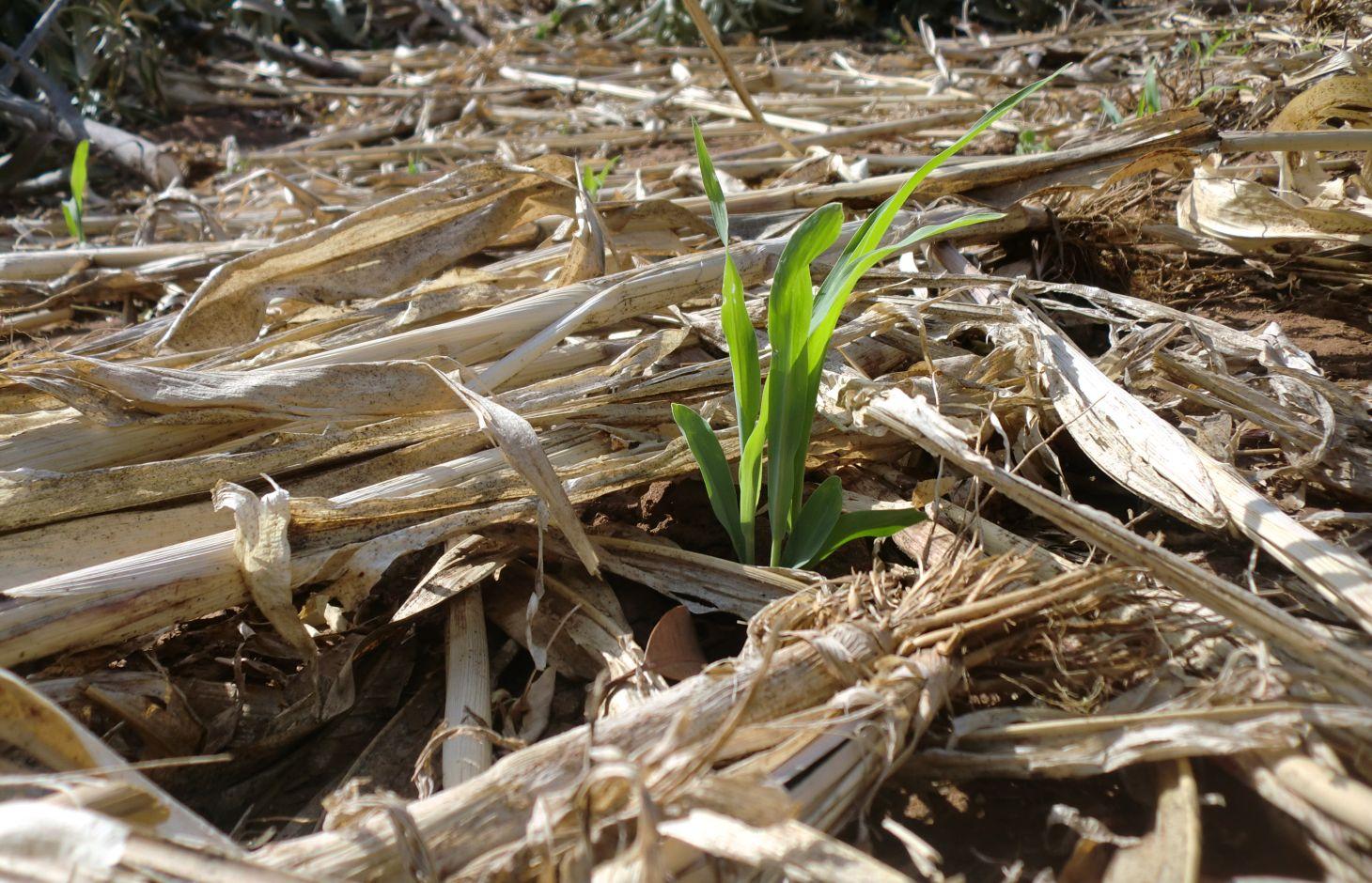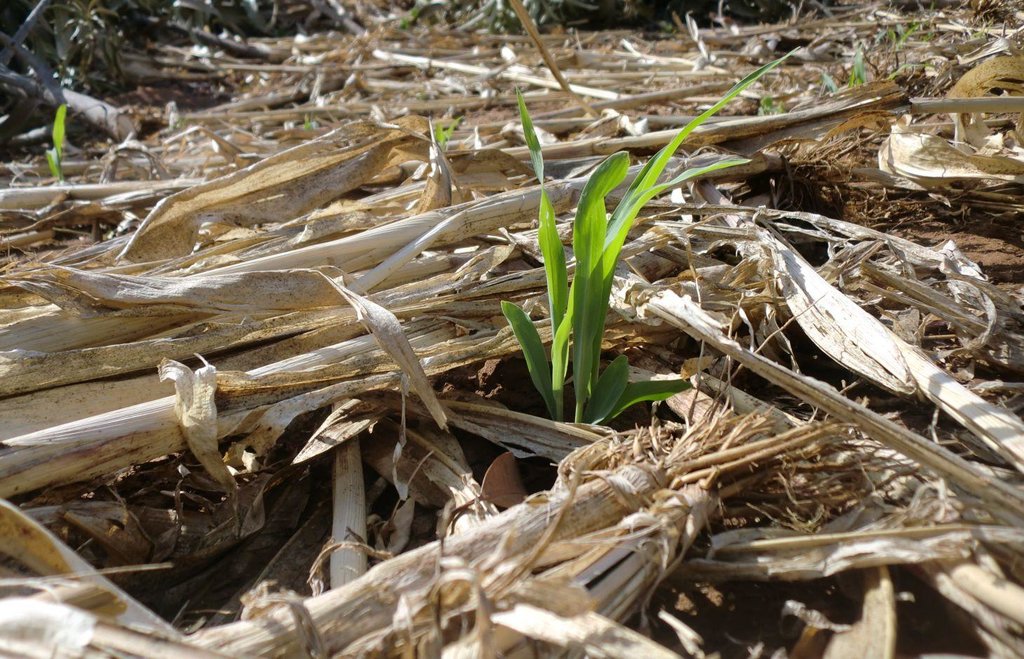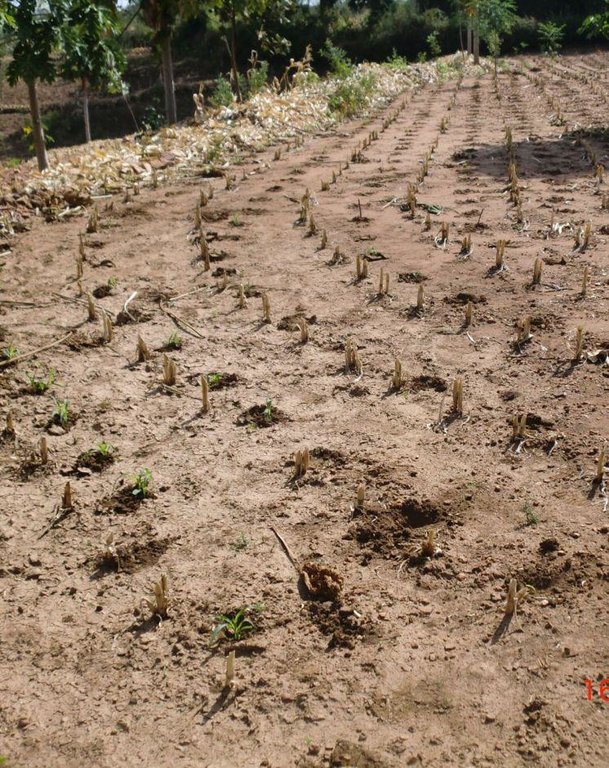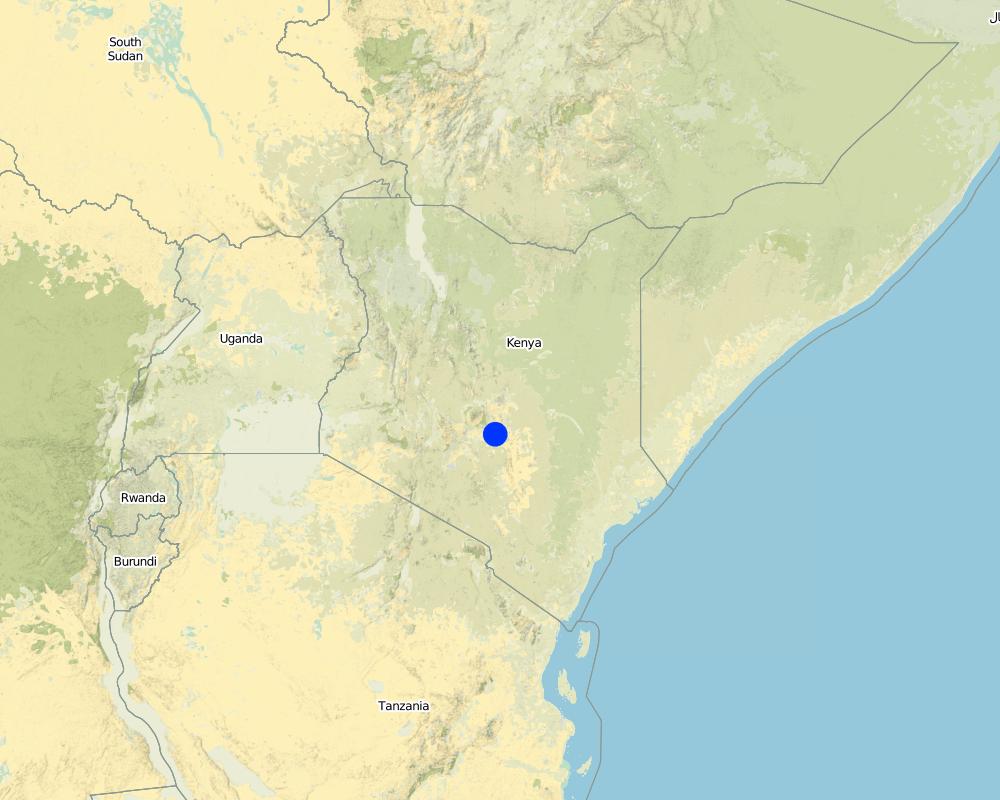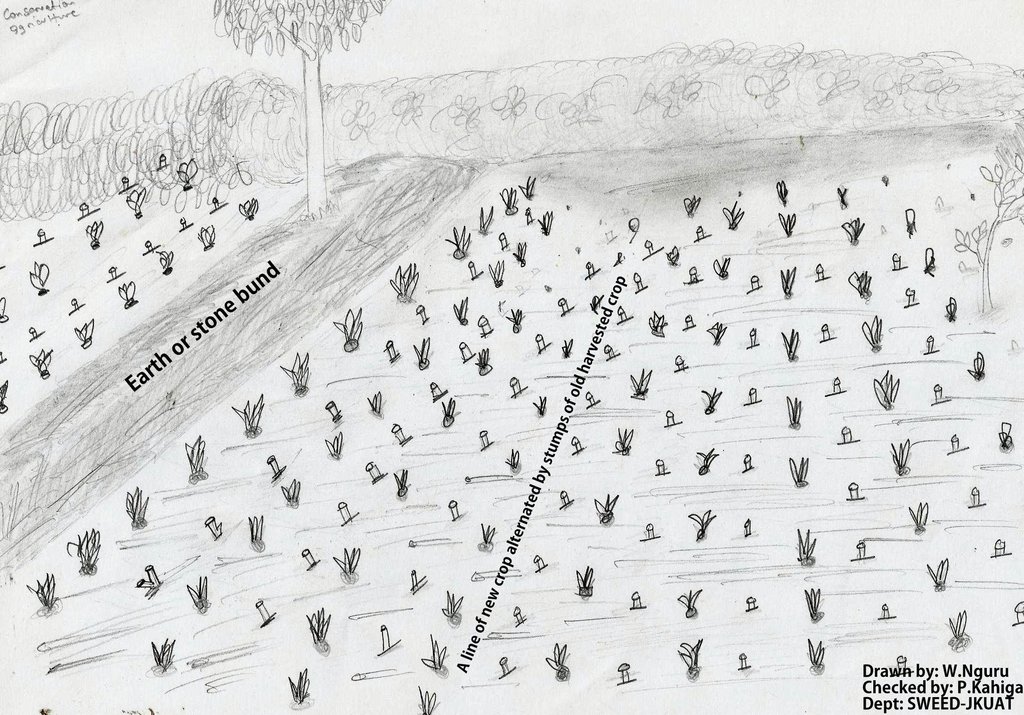Conservation Agriculture [肯尼亚]
- 创建:
- 更新:
- 编制者: Paul Kahiga
- 编辑者: –
- 审查者: Fabian Ottiger
Conservation Agriculture
technologies_1323 - 肯尼亚
查看章节
全部展开 全部收起1. 一般信息
1.2 参与该技术评估和文件编制的资源人员和机构的联系方式
SLM专业人员:
Gathenya Mwangi
Jomo Kenyatta University of Agriculture and Technology
P.O.Box, 62000-00200, Nairobi, Juja
肯尼亚
SLM专业人员:
Home Patrick
Jomo Kenyatta University of Agriculture and Technology
P.O.Box, 62000-00200, Nairobi, Juja
肯尼亚
SLM专业人员:
Chege Timothy
Jomo Kenyatta University of Agriculture and Technology
P.O.Box, 62000-00200, Nairobi, Juja
肯尼亚
SLM专业人员:
Abamba Omwange
Jomo Kenyatta University of Agriculture and Technology
P.O.Box, 62000-00200, Nairobi, Juja
肯尼亚
SLM专业人员:
Baobab Kimengich
Jomo Kenyatta University of Agriculture and Technology
P.O.Box, 62000-00200, Nairobi, Juja
肯尼亚
SLM专业人员:
Wamuongo Jane
+254 729 054547
Kenya Agricultural Research Institute
Nairobi
肯尼亚
SLM专业人员:
Karanja Andrew
+254 729 054547
Kenya Agricultural Research Institute
Nairobi
肯尼亚
SLM专业人员:
Namirembe Sara
+254 20 7224000
World Agroforestry Centre (ICRAF)
Address: United Nations Avenue, P. O. Box 30677, Nairobi, Kenya
肯尼亚
有助于对技术进行记录/评估的机构名称(如相关)
KARI Headquarters (KARI Headquarters) - 肯尼亚有助于对技术进行记录/评估的机构名称(如相关)
Jomo Kenyatta University (Jomo Kenyatta University) - 肯尼亚有助于对技术进行记录/评估的机构名称(如相关)
International Centre for Research in Agroforestry (ICRAF) - 肯尼亚1.3 关于使用通过WOCAT记录的数据的条件
(现场)数据是什么时候汇编的?:
19/09/2012
编制者和关键资源人员接受有关使用通过WOCAT记录数据的条件。:
是
1.4 所述技术的可持续性声明
这里所描述的技术在土地退化方面是否存在问题,导致无法被认为是一种可持续的土地管理技术?:
否
2. SLM技术的说明
2.1 技术简介
技术定义:
Conservation Agriculture is a concept for resource-saving agricultural crop production that strives to achieve acceptable profits together with high and sustained production levels while concurrently conserving the environment.
2.2 技术的详细说明
说明:
Conservation Agriculture (CA) is an approach to managing agro-ecosystems for improved and sustained productivity, increased profits and food security while preserving and enhancing the resource base and the environment. Conventional "arable" agriculture is normally based on soil tillage as the main operation. The technology is mainly practiced in the dry areas of Mbeere District where farmers experience very dry spells in most times of the year.
Purpose of the Technology: Conservation agriculture (CA) aims to achieve sustainable and profitable agriculture and subsequently aimes at improved livelihoods of farmers through the application of the three CA principles: minimal soil disturbance, permanent soil cover and crop rotations. CA holds tremendous potential for all sizes of farms and agro-ecological systems, but its adoption is perhaps most urgently required by smallholder farmers, especially those facing acute labour shortages. It is a way to combine profitable agricultural production with environmental concerns and sustainability and it has been proven to work in a variety of agroecological zones and farming systems.
Establishment / maintenance activities and inputs: The first key principle in CA is practicing minimum mechanical soil disturbance which is essential to maintaining minerals within the soil, stopping erosion, and preventing water loss from occurring within the soil.The second key principle in CA is much like the first in dealing with protecting the soil. The principle of managing the top soil to create a permanent organic soil cover can allow for growth of organisms within the soil structure. This growth will break down the mulch that is left on the soil surface. The breaking down of this mulch will produce a high organic matter level which will act as a fertilizer for the soil surface.The third principle is the practice of crop rotation with more than two species.Crop rotation can also help build up soil infrastructure. Establishing crops in a rotation allows for an extensive buildup of rooting zones which will allow for better water infiltration.
Natural / human environment: CA principles are universally applicable to all agricultural landscapes and land uses with locally adapted practices. CA enhances biodiversity and natural biological processes above and below the ground surface. Soil interventions such as mechanical soil disturbance are reduced to an absolute minimum or avoided, and external inputs such as agrochemicals and plant nutrients of mineral or organic origin are applied optimally and in ways and quantities that do not interfere with, or disrupt, the biological processes.
2.3 技术照片
2.5 已应用该技术的、本评估所涵盖的国家/地区/地点
国家:
肯尼亚
区域/州/省:
Eastern Province
有关地点的进一步说明:
Mbere South District
Map
×2.7 技术介绍
详细说明该技术是如何引入的:
- 通过土地使用者的创新
3. SLM技术的分类
3.1 该技术的主要目的
- 改良生产
- 减少、预防、恢复土地退化
- 创造有益的经济影响
3.2 应用该技术的当前土地利用类型

农田
- 一年一作
主要农作物(经济作物及粮食作物):
Major cash crop: Green grams
Major food crop: Maize
注释:
Major land use problems (compiler’s opinion): High moisture loss from the soil due to evaporation
Major land use problems (land users’ perception): Low crop production
Future (final) land use (after implementation of SLM Technology): Cropland: Ca: Annual cropping
如果由于技术的实施而导致土地用途发生变化,则在技术实施前说明土地利的用途。:
Cropland: Ct: Tree and shrub cropping
3.3 有关土地利用的更多信息
该技术所应用土地的供水:
- 雨养
每年的生长季节数:
- 1
具体说明:
Longest growing period in days: 360
牲畜密度(如相关):
< 1 LU/km2
3.4 该技术所属的SLM组
- 轮作制度(轮作、休耕、轮垦)
- 改良的地面/植被覆盖
- 最小的土壤扰动
3.5 技术传播
具体说明该技术的分布:
- 均匀地分布在一个区域
如果该技术均匀地分布在一个区域上,请注明覆盖的大致区域。:
- < 0.1 平方千米(10 公顷)
3.6 包含该技术的可持续土地管理措施

农艺措施
- A2:有机质/土壤肥力
注释:
Type of agronomic measures: mulching, manure / compost / residues, zero tillage / no-till
3.7 该技术强调的主要土地退化类型

生物性退化
- Bq:数量/生物量减少
注释:
Main causes of degradation: soil management
3.8 防止、减少或恢复土地退化
具体数量名该技术与土地退化有关的目标:
- 防止土地退化
- 修复/恢复严重退化的土地
4. 技术规范、实施活动、投入和成本
4.1 该技术的技术图纸
4.2 技术规范/技术图纸说明
The technical drawing on the left side shows rows of newly planted maize crops alternated by trumps of previous rows of old harvested crop. The previous crop residues are either collected and used as animal feeds or put on rows along the contours to supplement the earth or stone bunds.
Location: Mbeere South District. Eastern Province
Date: 02/09/2012
Technical knowledge required for field staff / advisors: moderate
Technical knowledge required for land users: moderate
Main technical functions: control of raindrop splash, control of dispersed runoff: retain / trap, improvement of ground cover, increase of surface roughness
4.3 有关投入和成本计算的一般信息
其它/国家货币(具体说明):
Kshs
注明美元与当地货币的汇率(如相关):1美元=:
100.0
注明雇用劳工的每日平均工资成本:
5.00
4.4 技术建立活动
| 活动 | 措施类型 | 时间 | |
|---|---|---|---|
| 1. | Purchase Seeds | 农业学的 | |
| 2. | Purchase Panga | 农业学的 | |
| 3. | Purchase Hoe | 农业学的 |
注释:
Life span of seeds: 1 year
Life span of panga: 2 years
Life span of hoe: 3 years
4.5 技术建立所需要的费用和投入
| 对投入进行具体说明 | 单位 | 数量 | 单位成本 | 每项投入的总成本 | 土地使用者承担的成本% | |
|---|---|---|---|---|---|---|
| 劳动力 | Labour | ha | 1.0 | 50.0 | 50.0 | 100.0 |
| 设备 | Tools | ha | 1.0 | 15.0 | 15.0 | 100.0 |
| 植物材料 | Seeds | ha | 1.0 | 50.0 | 50.0 | 100.0 |
| 肥料和杀菌剂 | Biocides | ha | 1.0 | 20.0 | 20.0 | 100.0 |
| 技术建立所需总成本 | 135.0 | |||||
注释:
Duration of establishment phase: 6 month(s)
4.6 维护/经常性活动
| 活动 | 措施类型 | 时间/频率 | |
|---|---|---|---|
| 1. | weeding | 农业学的 | 2 |
| 2. | harvesting | 农业学的 | 1 |
4.7 维护/经常性活动所需要的费用和投入(每年)
| 对投入进行具体说明 | 单位 | 数量 | 单位成本 | 每项投入的总成本 | 土地使用者承担的成本% | |
|---|---|---|---|---|---|---|
| 劳动力 | Labour | ha | 1.0 | 30.0 | 30.0 | 100.0 |
| 设备 | Tools | ha | 1.0 | 50.0 | 50.0 | 100.0 |
| 植物材料 | Seeds | ha | 1.0 | 20.0 | 20.0 | 100.0 |
| 肥料和杀菌剂 | Biocides | ha | 1.0 | 20.0 | 20.0 | 100.0 |
| 技术维护所需总成本 | 120.0 | |||||
4.8 影响成本的最重要因素
描述影响成本的最决定性因素:
Labour is the most determinate factor affecting the costs.
5. 自然和人文环境
5.1 气候
年降雨量
- < 250毫米
- 251-500毫米
- 501-750毫米
- 751-1,000毫米
- 1,001-1,500毫米
- 1,501-2,000毫米
- 2,001-3,000毫米
- 3,001-4,000毫米
- > 4,000毫米
农业气候带
- 半干旱
Thermal climate class: tropics
5.2 地形
平均坡度:
- 水平(0-2%)
- 缓降(3-5%)
- 平缓(6-10%)
- 滚坡(11-15%)
- 崎岖(16-30%)
- 陡峭(31-60%)
- 非常陡峭(>60%)
地形:
- 高原/平原
- 山脊
- 山坡
- 山地斜坡
- 麓坡
- 谷底
垂直分布带:
- 0-100 m a.s.l.
- 101-500 m a.s.l.
- 501-1,000 m a.s.l.
- 1,001-1,500 m a.s.l.
- 1,501-2,000 m a.s.l.
- 2,001-2,500 m a.s.l.
- 2,501-3,000 m a.s.l.
- 3,001-4,000 m a.s.l.
- > 4,000 m a.s.l.
5.3 土壤
平均土层深度:
- 非常浅(0-20厘米)
- 浅(21-50厘米)
- 中等深度(51-80厘米)
- 深(81-120厘米)
- 非常深(> 120厘米)
土壤质地(表土):
- 中粒(壤土、粉土)
表土有机质:
- 中(1-3%)
如有可能,附上完整的土壤描述或具体说明可用的信息,例如土壤类型、土壤酸碱度、阳离子交换能力、氮、盐度等。:
Soil fertility: Medium
Soil drainage/infiltration: Medium
Soil water storage capacity: Medium
5.4 水资源可用性和质量
地下水位表:
5-50米
地表水的可用性:
中等
水质(未处理):
不良饮用水(需要处理)
5.5 生物多样性
物种多样性:
- 低
5.6 应用该技术的土地使用者的特征
生产系统的市场定位:
- 混合(生计/商业
非农收入:
- 收入的10-50%
相对财富水平:
- 平均水平
个人或集体:
- 个人/家庭
机械化水平:
- 手工作业
- 畜力牵引
性别:
- 女人
- 男人
说明土地使用者的其他有关特征:
Land users applying the Technology are mainly common / average land users
Population density: < 10 persons/km2
Annual population growth: 0.5% - 1%
5.7 应用该技术的土地使用者拥有或租用的平均土地面积
- < 0.5 公顷
- 0.5-1 公顷
- 1-2 公顷
- 2-5公顷
- 5-15公顷
- 15-50公顷
- 50-100公顷
- 100-500公顷
- 500-1,000公顷
- 1,000-10,000公顷
- > 10,000公顷
这被认为是小规模、中规模还是大规模的(参照当地实际情况)?:
- 小规模的
5.8 土地所有权、土地使用权和水使用权
土地所有权:
- 州
- 个人,有命名
土地使用权:
- 个人
用水权:
- 个人
5.9 进入服务和基础设施的通道
健康:
- 贫瘠
- 适度的
- 好
教育:
- 贫瘠
- 适度的
- 好
技术援助:
- 贫瘠
- 适度的
- 好
6. 影响和结论性说明
6.1 该技术的现场影响
社会经济效应
生产
作物生产
饲料生产
生产故障风险
土地管理
收入和成本
农业收入
收入来源的多样性
社会文化影响
SLM/土地退化知识
Improved livelihoods and human well-being
生态影响
水循环/径流
地表径流
土壤
土壤水分
土壤覆盖层
土壤有机物/地下C
6.2 该技术的场外影响已经显现
缓冲/过滤能力
6.3 技术对渐变气候以及与气候相关的极端情况/灾害的暴露和敏感性(土地使用者认为的极端情况/灾害)
渐变气候
渐变气候
| 季节 | 气候变化/极端天气的类型 | 该技术是如何应对的? | |
|---|---|---|---|
| 年温度 | 增加 | 好 |
气候有关的极端情况(灾害)
气候灾害
| 该技术是如何应对的? | |
|---|---|
| 干旱 | 好 |
6.4 成本效益分析
技术收益与技术建立成本相比如何(从土地使用者的角度看)?
短期回报:
积极
长期回报:
积极
技术收益与技术维护成本/经常性成本相比如何(从土地使用者的角度看)?
短期回报:
积极
长期回报:
积极
6.5 技术采用
注释:
There is a moderate trend towards spontaneous adoption of the Technology
6.7 该技术的优点/长处/机会
| 编制者或其他关键资源人员认为的长处/优势/机会 |
|---|
| Improves soil structure and protects the soil against erosion and nutrient losses by maintaining a permanent soil cover and minimizing soil disturbance. |
| Enhance soil organic matter (SOM) levels and nutrient availability by utilizing the previous crop residues |
| Soil nutrient supplies and cycling are enhanced by the biochemical decomposition of organic crop residues at the soil surface that are also vital for feeding the soil microbes |
6.8 技术的弱点/缺点/风险及其克服方法
| 编制者或其他关键资源人员认为的弱点/缺点/风险 | 如何克服它们? |
|---|---|
| Contamination of water ecosystems by herbicides | Use the right doses of herbicides and follow instructions of the manufacturer |
| Reduced fodder production as some of the crop residuals that are supposed to be fed to the animals are used as soil cover materials | Use of other crop residuals to supplement cover materials |
7. 参考和链接
7.1 信息的方法/来源
- 实地考察、实地调查
- 与土地使用者的访谈
链接和模块
全部展开 全部收起链接
无链接
模块
无模块


